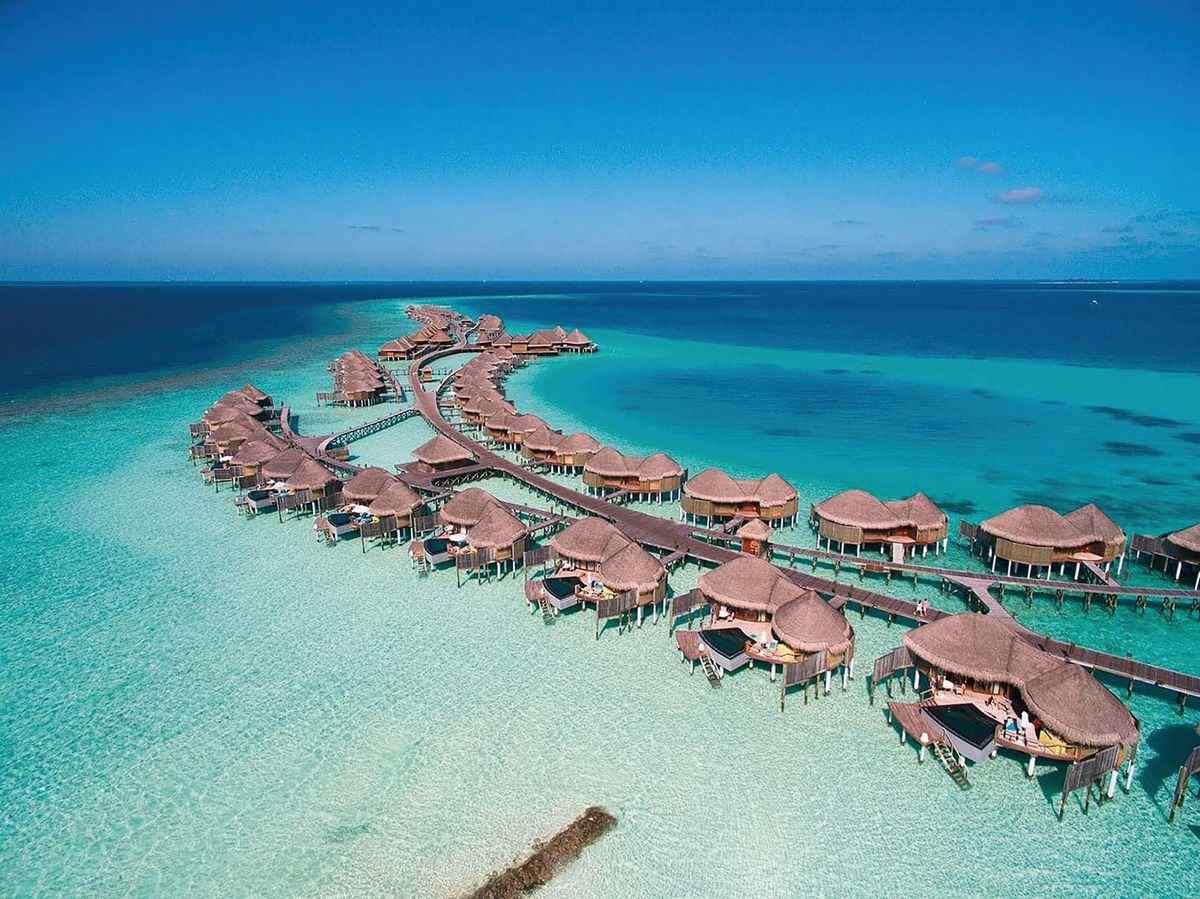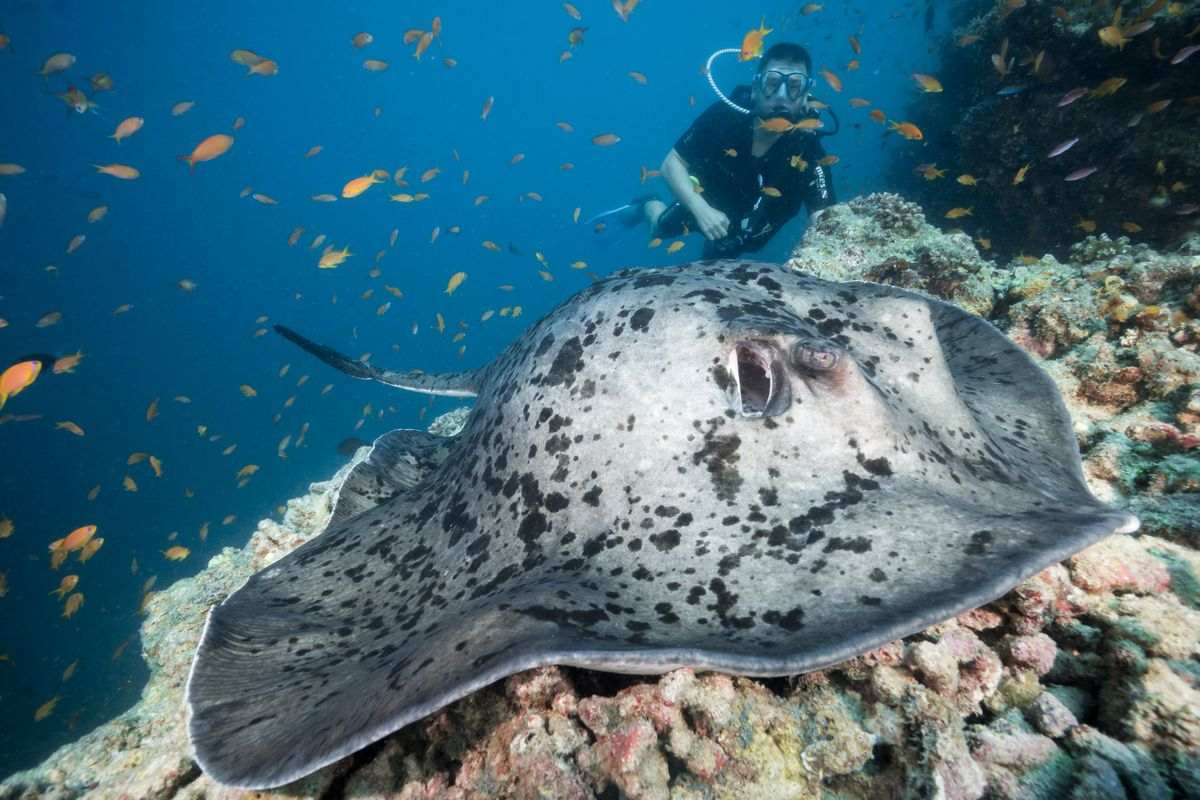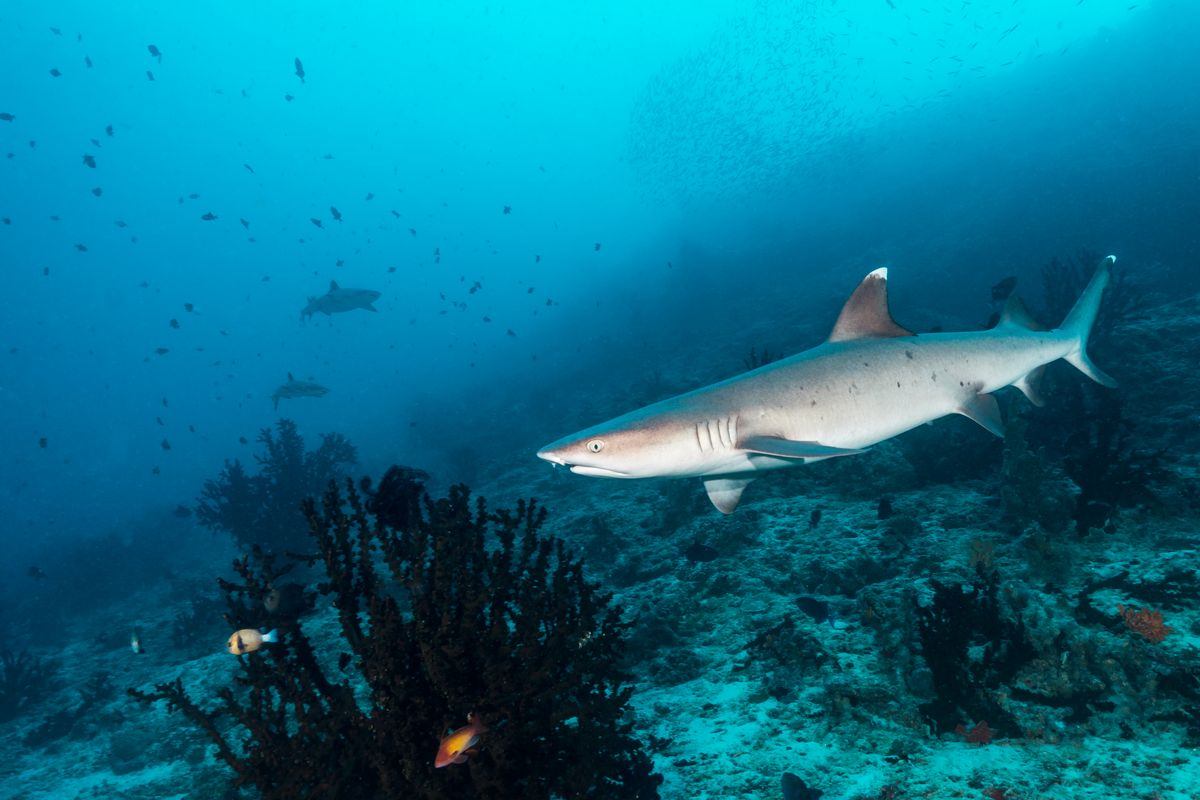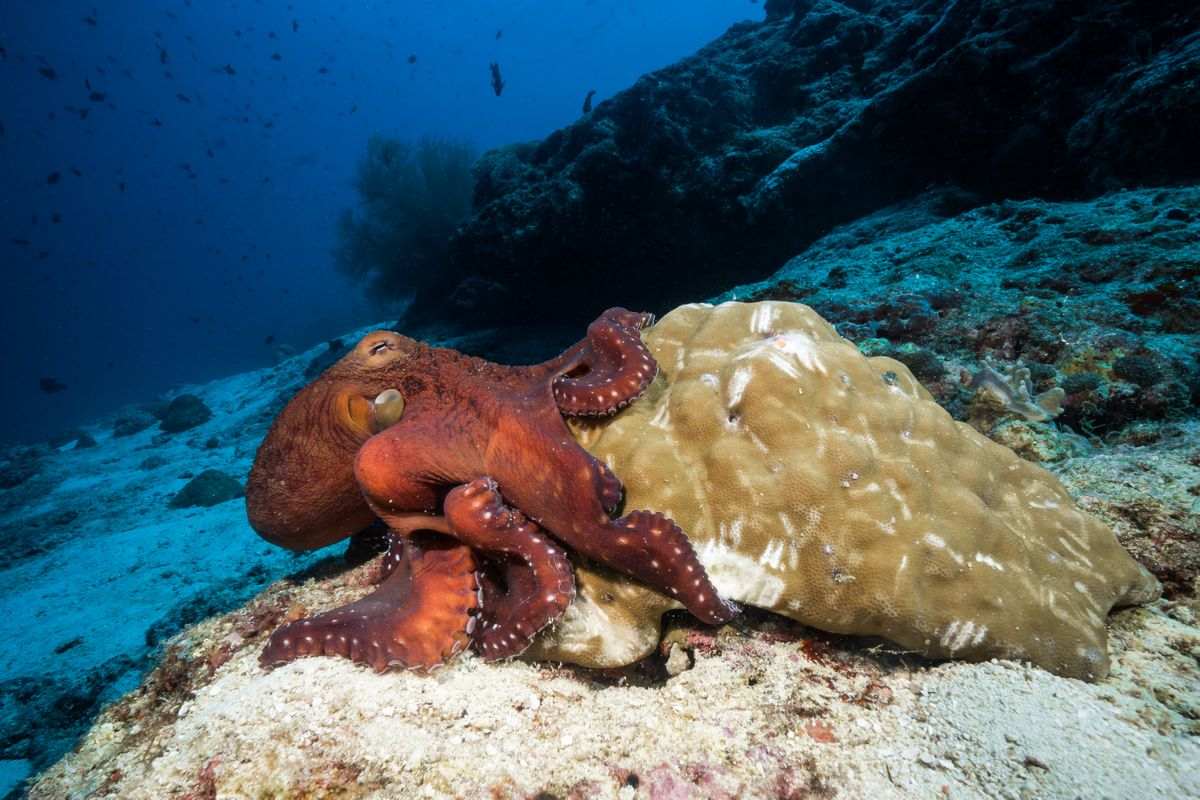
The vast Ari Atoll is blessed with some of the Maldives’ top dive sites and almost as impressive hotels. Chloe Smith found both irresistible. Photographs by James Emery
Ari is one of the biggest atolls in the Maldives. It stretches 80 kilometres from north to south and is about 30km wide. It sits on the western side of the archipelago, roughly parallel with Male Atoll, home to the international airport and the nation’s capital. Its location and vast size made it a favoured destination for the liveaboards which first opened up the Maldives for diving in the 1970s – and what they found was a staggering array of world-class dive sites.
In the central belt of the atoll (it is one atoll divided into north and south for administrative purposes) sits a unique collection of sites: Maaya Thila, Bojahamadi, Fish Head, Himandhoo, Bathala Thila, Kalhuhadhihuraa Thila, Blue Caves and many more. Most of the diving is on thilas – isolated submerged outcrops in the expanse of the 267 square kilometre lagoon, some small enough to swim around easily in one dive and often with flat tops covered in coral gardens, with steep sides that plunge 30m or more to the seafloor.
The thilas act as beacons for marine life in the relative emptiness of the open ocean, and they are regularly swept with nutrient-rich currents pumping in and out of the atoll with each tide. These remarkable ecosystems sustain a phenomenal amount of life – tiny macro critters nestling in the soft and hard corals, large schools of grazing fish, and a healthy chain of predators topped by an impressive amount of sharks. The plankton, which can swirl around these outcrops in astronomical aggregations, attract giant filter feeders such as manta rays and whale sharks.

Despite the many challenges of climate change and over-development that the Maldives’ islands face, Ari Atoll still supports an unsurpassed array of world-class diving. Another advantage of its scale but relative nearness to international travel is that it now has an impressive range of top-class hotels spread generously across large tracts of deserted ocean. I was here to check out two of the best, Constance Moofushi and Constance Halaveli, one on each side of the atoll, but both with excellent access to those star dive sites.
Touching down at sunset on a seaplane is as good as it sounds: orange sky, millpond blue waters and a special herbal tea to ward off jetlag greeted us. The resort has 24 beach villas and 56 water villas, two restaurants (one fine dining and another buffet-style). There is a sign visible on landing, which states ‘No Shoes, No News’. The architecture is traditional Maldivian, with lots of dark woods, and it has an upmarket eco feel – no motorised water sports such as jet skis are allowed, as it disturbs the turtles on the house reef.
Later that evening we meet Christian, the dive centre owner, who enthusiastically tells us about the exquisite diving around the resort that he has been exploring for the past 20 years. ‘Mantas are the big draw to Moofushi,’ he tells us. ‘The site is only minutes away and we are very lucky in high season to see so many’. On the south side of the Moofushi channel, just fifteen minutes by boat from the resort, sits Bojahamadi, a world-famous manta ray cleaning station. There is a large plateau at five metres which drops away to a ledge at 20m. On the east side of this plateau between 12 and 20m is a big coral block where you can see bluestriped snapper, groupers and oriental sweetlips.
Christian points out as we head to the site on a dhoni on what seems an extremely quiet Sunday morning: ‘In a strong current you will see the mantas hover above the cleaning station, and in that case we will hook onto the reef and watch them for as long as your air permits. In a weaker current they will swoop around the station and we will follow them slowly.’ He goes on to warn us that due to the popularity of this site we may see lots of other divers, and the amount of bubbles can sometimes scare the manta rays away. As we get closer to the site Christian has a smile on his face, ‘Look! No boats!’ He explains: ‘If you come on Sundays the safari boats are usually back in Malé collecting their next guests. Sometimes there are other hotel boats, but today we have struck gold!’
There are just three of us on this dive. ‘Are you ready for this?’ asks Christian grinning. We descend to 20m a medium-to-strong current, and look up to see three manta rays in formation above our heads. Then the action begins: countless more manta rays are swooping around the cleaning station while we swim up to the plateau at around 14m and hook onto the reef. The spectacle is breathtaking. We remain as still as possible as the mantas become more confident and soon are centimetres from us, brushing our heads with their huge, supple bodies.
A female manta ray is chased by a chain of males, some breaking off to impress her with barrel rolls and underwater acrobatics. There are so many of them, it’s hard to know where to look. The Maldives has the world’s largest population of reef manta rays (Mobula alfredi) estimated to be more than 10,000 individuals. Some believe the true number could be double that figure. Slightly smaller than the oceanic manta ray (Mobula birostris), they can still grow to a disc size of 5m, while most are around 3.5m wide. Observing them from such close range you see how perceptive and aware they are, they watch you with big eyes and seem to be cognizant and curious about the world around them, much more so than most fish.

Manta rays have the largest brain of any fish species, and the largest brain compared to their body weight of any of the batoids (the superorder of cartilaginous fishes commonly known as rays). A study by the Manta Pacific Research Foundation showed they have enlarged brain areas associated with intelligence, vision and motor coordination. They are one of the few species, including great apes and bottlenose dolphins, which can recognise their own reflection in a mirror – a standard test indicating self-awareness.
Sadly, our air runs low and we are forced to ascend. My buddy is speechless, I am wondering if we are still on Planet Earth and Christian looks as if he is about to burst. ‘I counted 15!’ he exclaims. ‘Fifteen!’ It is common to see five or six manta rays at Bojahamadi. We dived it on a second occasion, this time with the company of safari boats and day boats. There were still a good number of mantas, seven or eight swooping around. But with the added traffic of around 40 divers at the site, it did not have the magic of the first dive.
Another top manta ray site is the nearby Himandhoo Thila, which is long and narrow, with a reef-top depth of 10m and gently sloping sides. The manta rays were not there when we dived the site, but the caves and overhangs on the south side of the thila are not to be missed. There are soft corals covering the walls, and large, brightly coloured gorgonians flapping in the current. We drifted along the reef side in a turbo current, catching glimpses of a hungry hawksbill turtle feasting on the soft corals, a large black-spotted pufferfish and walls of glassfish.

Just a short 30-minute speedboat ride across the atoll, we reached our second destination, Constance Halaveli. This is also a five-star luxury resort from the same hotel group. Halaveli is a tad more upmarket and glitzy than Moofushi. The island is larger, they have a presidential villa and its wine list is one of the most extensive in the Maldives. We are served welcome drinks in gold pineapples before being whisked off on a tour of the resort. There are 57 water villas, 11 family beach villas, nine single-storey beach villas, eight double-storey beach villas and a presidential suite which sleeps nine.
Each beach villa is built so that the garden is private, a good thing as there is a bath bang in the middle of each garden. You can choose from four different restaurants, including a sushi bar and pan-Asian fine dining. There is an award-winning spa which overlooks the Indian Ocean with glass holes in the floor so you can watch the underwater world while having a massage. As you are being pummelled, you discover that a remarkable number of juvenile blacktip sharks swim close to the island shore. Walking to dinner at sunset we spot four more adolescent blacktips chasing a stingray.
The diving is run by TGI Maldives. The company has a dive ratio of one guide to two divers and it runs three dives a day from the centre and will take requests for sites to visit if guests have a preference. You can also hire a private boat and guide, wallet permitting. ‘We get lots of high-powered CEOs who have been diving for twenty-plus years wanting see sharks,’ says James, one of our guides for the week. He says he cannot guarantee we will see sharks, but it is highly likely.

Sharks are now protected across all Maldivian waters – but fishing had been common for decades and in most atolls, sharks are a rare sight. Ari is one of the few places where there are now reasonable numbers – probably another benefit of the sheer scale of the atoll’s lagoon. Allegedly, the dive site Fish Head was named by fisherman because most of the fish they reeled in came up with only the head, as sharks had taken the rest. Another theory claims the rock at the centre of the site looks like a fish head. Its official name, however, is Mushimas Migili, with a much less exciting story – that is the name of the small brown fusilier that is found in huge numbers at the thila. It’s now a marine-protected area around 100m long; the top reef starts at 8m, going down to a maximum depth of 42m. It sits just inside of the atoll, in front of a major channel, and the tides can be raging.
The currents bring in a large number of grey reef sharks, almost exclusively females. Many divers talk about the large pregnant female they often see, as she comes very close to divers and is playful in her behaviour. The chances are that this is probably a number of different sharks; they all seem comfortable with sharing the water with divers. The sharks circle the drop-off at one end of the thila. They dart around and pass within a few metres of you, with their grey, sleek bodies, and their inquisitive eyes staring at you. It is not just the sharks that make Fish Head special though – the sheer number of fish at the site is astounding. in the overhang of the Fish Head there are thousands of bluelined snapper and jacks feast on the glassfish and fusiliers.
The reef is undercut with an overhang which runs along a large portion of the thila, here you find large gorgonians and black coral trees decorated with feather stars. Just on the outside of the atoll is a small thila called Bathala. This site is not as well known as the others we dived, but we struck lucky and saw a huge variety of life. During our briefing, dive guide Jenna explained: ‘In a moderate current you can swim around the thila in one dive. In a strong current, we jump onto the front of the thila and we should see lots of sharks.’

When we arrive at the site the current is very strong, promising for shark encounters, but we are warned to be careful as the thila is narrow and it is easy to be swept off the site. We descend onto the reef top, using what feels like an Olympian level of effort to reach the thila edge. Hooked onto the reef, we are confronted with half a dozen whitetip reef sharks circling in front of us. Swimming calmly in the current, they get progressively closer to us as the dive goes on, coming to investigate and darting back out into the blue. Grey reef sharks appear halfway through the dive, and two large eagle rays flap around in this spectacular underwater show.
Classed as a marine reserve by the Maldivian government, Maaya Thila is located in the northeastern part of the atoll. It’s a tiny thila, so small that you can swim around it in one dive. It is only 30m in diameter. However, this is what makes this site so exciting. As the thila is so small, it is crowded with marine life. ‘Look for the mating octopuses’ said Jenna, explaining their courting habits. ‘The male argonaut octopuses have a detachable arm which they offer to the female with their sperm on the end. They will sometimes offer you their courting tentacle if you remain still enough’.
With mixed feelings about sex play with an octopus, we jump into the water descending to the top of the thila at around 8m. On the northern edge, there is a large overhang full of beautiful, brightly coloured tubastrea soft corals. Out in the blue sits a large satellite rock covered in hard and soft corals, sloping down 40m to the atoll plate. Below, we see five large grey reef sharks patrolling the channel between the satellite rock and the thila. On the channel floor, there are whitetip reef sharks resting in the sand. Ascending back up to the reef top there is a drunken looking stonefish, zebra morays, fusiliers, and bluestripe snappers. We come across a friendly octopus, but he does not seem to trust us enough to offer his special arm. There is also a large resident hawksbill turtle, gorging on the coral.

This was a dive teeming with life and yet Jenna assured us that we have not seen the best of Maaya Thila. We have a night dive later that day. As the sun begins to set we head back out on the dhoni from the hotel to experience one of the world’s best night dives. At night, the thila becomes a playground for predators. We descend with the setting sun above our heads, and drift along the wall, a very friendly blotched stingray joining us for the first half of the dive, following the torchlight and enjoying our illuminating company. There are vast schools of pigmy sweepers being hunted by giant trevallies; the schools swim so quickly and erratically they dart into our faces, causing us to guffaw underwater.
Shining our lights into the schooling fish they resemble a modern art installation with colour formations curling and changing shape in front of our eyes. The different types of fish present different colours as they weave around each other trying to avoid predatory mouths. Resting turtles sit sleepily in their nests in the overhangs, and hungry whitetip reef sharks patrol the reef top looking for their next meal. We ascend to the surface and the laughter continues, something to do with the wonder and exhilaration of the dive seems to have sent everyone giddy. Making our way back to the hotel in the pitch black, seated on top of the dhoni, we stare at the stars, drink tea and marvel at what we have just experienced. Maaya Thila should be on every diver’s bucket list, both day and night, it’s an experience unlike any other. Poetry in motion!
Original Diving (+ 44 (0)20 3911 0428, www.originaldiving.com) offers three nights at Moofushi in a beach villa on an all-inclusive basis and three nights at Halaveli in a water villa on a B&B basis from £6,675 per person. Price includes international flights from UK, seaplane transfers and six dives at each resort.
Constance Hotels: www.constancehotels.com Tel: +230 402 2999.


